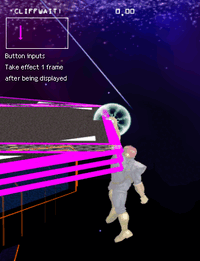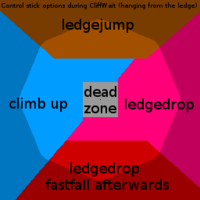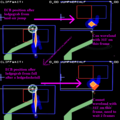User:Kadano/Ledgedashstall guide
I’d normally post this on Smashboards, but finding content here is much easier so I decided to try this out. I didn’t put it in "Ledgedashstall" because I felt a whole guide was too lengthy to go there.
Other users are not welcome to edit this unless their name is Magus420 or they only re-phrase passages that sound quirky (English isn’t my first language).
Captain Falcon[edit]
Captain Falcon is the character who has seen the most usage of this technique, so this guide will be focused on him for now.
Preparations[edit]
To ensure a wide range of input leniency for the airdodge part – which is important so that you don’t miss the edge – I recommend doing a single ledgehopstall (see appendix gallery) to refresh your ECB (environment collision box) to the most favorable status before you do a ledgedashstall. Because the ledgedashstall leaves you with a bad ECB, you should decide on either not doing consecutive ledgedashstalls or learn the timing for imperfect-ECB-ledgedashstalls. See appendix gallery for more information about this phenomenon.
Ledgegrab animation[edit]
Dubbed CliffCatch by the game. It’s completely intangible[1] and leaves the character with about half a second frames of intangibility after this animation has ended. The actual amount of frames varies depending on which action you choose and when you start counting. Dropping from the ledge isn’t possible straight from CliffCatch, so you need to wait until the first frame of CliffWait before you press down/away. See the illustration to the right for angles that trigger a drop. Note that fast-fall is only triggered if you keep that direction pressed for another frame; you can slow-fall even with a straight down angle.
As soon as you drop from the ledge, the game starts a count-down timer (DRP, disabled regrab period) that starts at 28 and prevents you from re-grabbing the ledge. At the same time, the intangibility count-down timer is also at 28. Thus, it is only possible to maintain sustained intangibility if you drop from the ledge at the first frame it is possible. Dropping from the ledge one frame later then possible will make you vulnerable to attacks for at least one frame before you re-grab the ledge.
To ensure you let go of the ledge as soon as possible, I recommend relying on your auditory reaction time to ensure the highest precision. Auditory reaction times are considerably slower than visual reaction times (~110ms vs. ~130ms are the respective top times) and you only have 7 frames – 120ms – to react if you want to drop on the first possible frame. Also, TVs usually process audio more quickly than video, so this makes auditory reaction even better. Of course, sound settings should be sufficiently loud so you can clearly hear the sound.
Assuming that you indeed dropped as early as possible, you have a total of eight leniency frames you can distribute on the timing of mid-air jump, airdodge and fast-fall almost however you want and still maintain sustained intangiblity.
Fall from the ledge[edit]
You can fall for up to 9 frames (1 forced and 8 leniency) before you press jump. If you choose to fast-fall, you need to jump after not more than 2 frames of the fast-fall else it would take too long until you get above the stage.
Jump[edit]
It’s very important that you hold forward all the way while pressing jump so that you can waveland as soon as possible.
Waveland[edit]
The earliest frame you can waveland on depends on your ECB that respectively depends on the body state the ledge was grabbed from. For the most favorable ECB and the earliest jump timing, you can waveland with 315° as soon as on frame 9 of your jump. For imperfect ECBs, it is frame 11. The latest possible frame to waveland on is frame 17 of your jump.
Fast-fall[edit]
Whether you need to fast-fall or not depends on how close to frame perfection you have been with the inputs so far. If you airdodge on frames 9-12 of your second jump and jumped as soon as possible, you need to not fast-fall in order to regrab the ledge. During your fall from the edge to the ledge, you need to hold towards the stage in most cases so that you don’t drift away from the ledge too far before the DRP timer reaches zero. It’s probably best to hold towards the stage immediately after inputting your airdodge if you opt for the no-fast-fall-timing. It’s more likely that you are much farther away from frame-perfection and thus need to fast-fall to make up for that and make your LGB (ledge grab box) collide with the ledge as soon as possible. Because the fast-fall decreases your Δx/Δy ratio compared to the no-fast-fall-timing, you don’t need to hold towards the stage. Still, it’s very important that you only press down a very short time as holding it down prevents you from grabbing the ledge.
Appendix[edit]
Gallery[edit]
<references>
- ^ Magus420 on collision bubble types, intangibility makes attacks pass right through the character whereas invincibility, which is used for re-spawn and other things, makes the attacker alone undergo hitlag.




